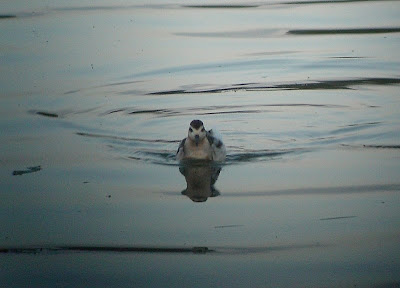The start of September also brought a number of Bullfinches in to the garden, male, female and juvenile all occasionally feeding on Honeysuckle berries next to the living room window, one occasion both female and juvenile showed incredibly well only inches away from the window. Numerous sightings from the surrounding lanes of male, female and juvenile birds in family groups from the end of August through to the present time.
A single Marsh Tit has returned to the garden much earlier than I recall it did last year, it seems to be very vocal at the moment and can often be heard long before it arrives at the feeders. The "pitchoo" call almost seems to drown out the rest of the garden birds usual chatter and moments later it arrives on top of the feeder pole, a few more calls and a quick view round the garden before it drops to the feeders, after plucking a sunflower heart or peanut granule from the feeder it disappears over the hedge before returning and repeating the process again.
Chiffchaff Video
The first weekend of September brought a fair amount of Hirundines through often moments before rain showers started, Saturday 6th mid-day saw 100+ Swallows and House Martins feeding low over the fields during bad weather and throughout the week small groups have been passing through.
Tawny Owls have been calling in the evenings again fro over 3 weeks now which includes presumably our regular chimney pot hooter who seems to get active at about 4am, another called from a nearby wood today at 4pm(17th) and After a spell of obscurity they seem to appearing on telegraph poles all around the hambledon Valley. My first Barn Owl fro awhile was seen on the 16th at 19:00, driving past Arizona Farm towards Skirmett I spotted a Tawny Owl perched on a telegraph pole viewing the fields next to the road, I slowed down to watch it and noticed a ghostly white figure quartering the fields next to the farm. Driving 200yrds down the road I soon found a Barn Owl perched on the fence post by the Skirmett village sign and by luck I had remembered to take my binoculars with me. I parked up and watched it as it quartered the fields next to the road, it made a number of shallow dives before dropping in to the field and out of sight. I've been worried about our local barn Owls this year due to the extremely wet weather, their breeding success depends on good weather in order for them to hunt and successfully raise a brood of chicks, they aren't keen on wet weather and this summer being incredibly wet would have done them no favours.
A Fallow Deer and her fawn have slept in the paddock on a number of occasions recently and a number of small groups have passed through the garden. Badgers have been very active recently probably due to the wet weather, one of their favourite foods being worms which surface in wet weather is too good to miss and many of the surrounding lawns have been dug up. I watched 2 trotting out of the garden and in to the fields late evening on the 4th Sept. 4 separate sightings through August in different locations including one sighting of a single badger taken windfall under an apple tree along Shogmoor Lane.



.JPG)
.JPG)
.JPG)
.JPG)
.JPG)
.JPG)
.JPG)
.JPG)

.JPG)
.JPG)
.JPG)
.JPG)
.JPG)
.JPG)
.JPG)

.JPG)
.JPG)
.JPG)
.JPG)
.JPG)
.JPG)
.JPG)
.JPG)
.JPG)
.JPG)
.JPG)


